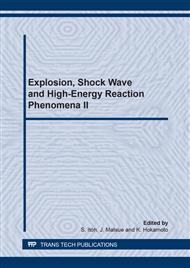p.1
p.9
p.15
p.23
p.29
p.35
p.41
p.47
Behaviors of High Explosive near the Critical Conditions for Shock Initiation of Detonation
Abstract:
The behaviors of the high explosive near the critical conditions for shock initiation of detonation are investigated by high speed photography and pressure measurements in gap tests. The sample is RDX base explosive, and the inner diameter of donor and acceptor charges is 26 mm. Gap material is PMMA. Near the critical condition, the results under the following conditions have been discussed. 1) Shock to detonation transition (SDT) take place in acceptor, 2) The SDT does not occur, but the reaction wave affects the leading shock front in acceptor, and 3) The gap length in which the effect of the reaction wave to shock front almost disappears. These results are very useful to construct the initiation model for solid explosive.
Info:
Periodical:
Pages:
15-22
Citation:
Online since:
November 2007
Authors:
Price:
Сopyright:
© 2008 Trans Tech Publications Ltd. All Rights Reserved
Share:
Citation:


